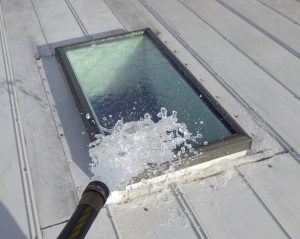Water Testing Roof Leaks
Why would you want us to water test your roof leak?
Water testing can serve several purposes. We recommend a water test as a first step in some cases so we can narrow down what the problem might be, in order to more accurately estimate the project. We can make it rain now, instead of waiting for rainy season. Usually we try to get in the attic so we can see the water drip right away. Then we can turn off the water. Waiting until the water makes it all the way down to the drywall and dripping inside, is not a good idea at all. If the attic is inaccessible, then maybe, but even then we would want to cut the drywall out to see the water when it first starts dripping. We have methods that we have perfected over time.
Other reasons for water testing might include:
- Client is not sure whether the leak is active or not. This can come up in a variety of situations. One in particular is when someone purchases a home and there is staining on the ceiling. The staining may have been there for several years and not changed since the roof was repaired, but the new owner doesn’t know that. So we can come in and make it rain.
- There has already been a repair and the client wants to be sure the leak is fixed. This comes up when there is other work to be done, like woodwork, flooring, or drywall and paint. So we can come in and make it rain and be doubly sure that the leak is repaired and not leaking before money is spent on the finish work.
- When we are trying to find the cause of the leak. This happens when there is more than 1 suspects like cracks in stucco, valley terminations, windows, or maybe a flat roof next to a sloped roof. Also, sometimes we can pinpoint the location to keep costs down when we are going in to do the roof repairs. This does not happen in every case, but happens often enough.
Water testing gives us a chance to investigate further. When we go to look at a roof leak or a roof problem, water is not running down the roof like when it is raining. The behavior of the situation is important to witness. Once we have seen the problem, we can determine whether or not a water test is needed. When we get into the attic, and there is a section of rotten wood, usually that is a telltale sign that there is a leak, the leak is active, and we know right where it is, not always though. So, in the case of rotten wood, a water test may not be needed.
After all that, once the roof is repaired, water testing can assure that the leak is finally fixed. You don’t know how many times we have had more than one situation leak. So what happens is we leave, expecting it was fixed only to have it leak again. Usually, it is not what we did, but something else close by. A water test would have shown us that there was still a leak and we could have repaired it right then. Then the work can be done to repair the damage.
We hear from customers and others that water testing makes the damage worse. We can’t disagree with this thinking more. The damage is already done.Well, usually if a roof leak has made it all the way down to where you can see it, it didn’t start yesterday. When there is rotten wood, it definitely didn’t start yesterday. One more time of the roof leak area getting wet, is not going to hurt anything. Especially if it is misdiagnosed and now how much time is going to pass, and how many more rains are going to go through? We are careful to turn off the water as soon as it starts leaking, so that there is no more damage to the interior.
This video of water testing a roof leak shows a case where the leak was way out of range of speculation. This roof had been attempted to be repaired once already. With a water test, and a little patience, we were able to find out the cause of this roof leak. It is definitely an eye opener. Guessing doesn’t always work.



